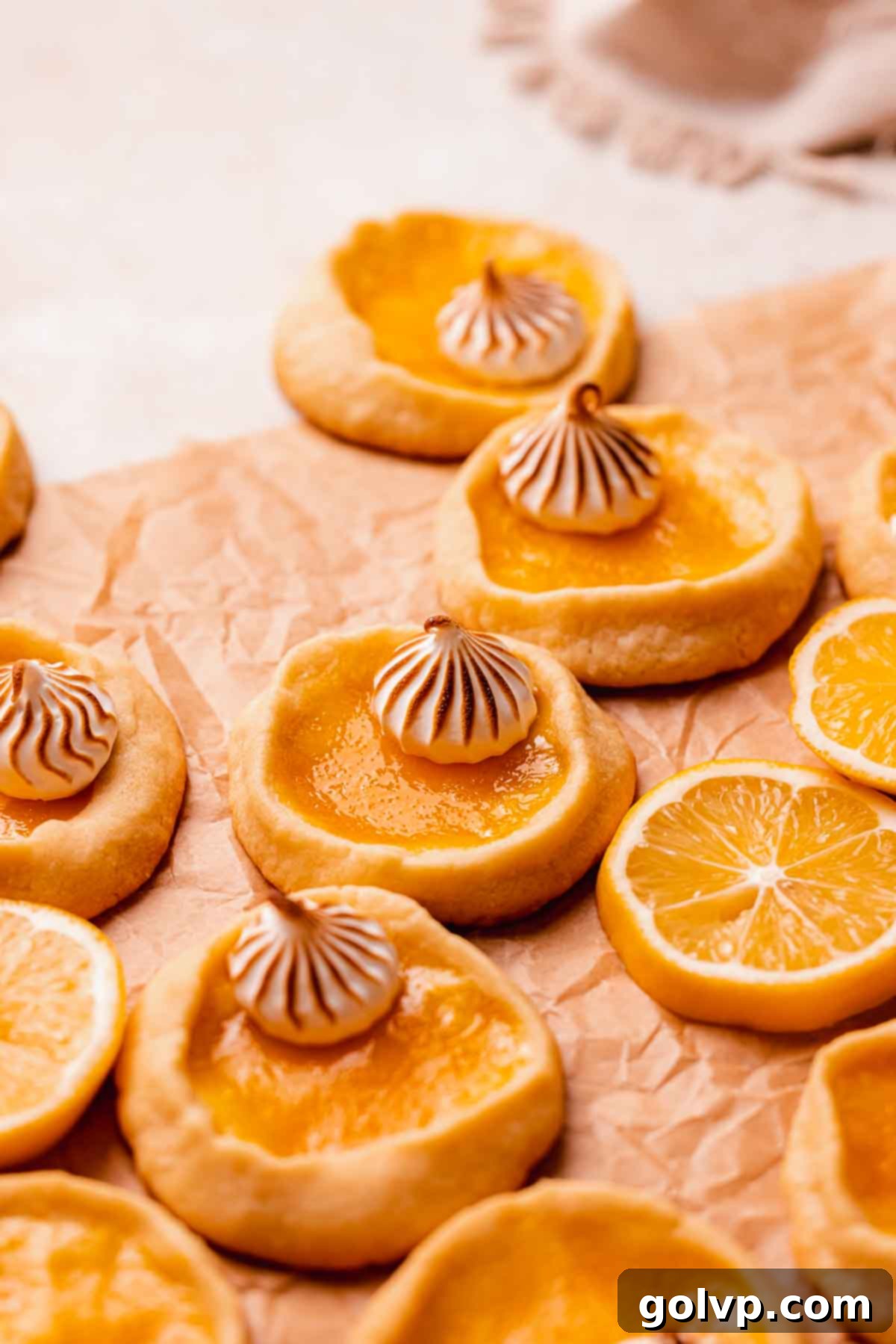Decadent Lemon Meringue Pie Cookies: The Ultimate Tangy Treat!
Prepare to fall in love with these extraordinary Lemon Meringue Pie Cookies – a delightful fusion of a classic lemon meringue pie transformed into an irresistible cookie form! Each bite offers an exquisite symphony of textures and flavors: a buttery, melt-in-your-mouth lemon shortbread cookie base, generously filled with a vibrant, tangy, and lusciously creamy lemon bar filling, all crowned with a cloud-like dollop of perfectly toasted Swiss meringue. This isn’t just a cookie; it’s an elevated lemon dessert experience designed to captivate any lemon lover’s palate. The interplay of buttery richness, zesty tartness, and light sweetness creates a truly unforgettable treat.
This unique cookie concept draws inspiration from my popular pumpkin pie cookies recipe. If you’re a fan of citrus-infused baked goods, be sure to explore more of my lemon creations, including my delightful lemon curd cookies and my irresistibly fudgy lemon brownies!
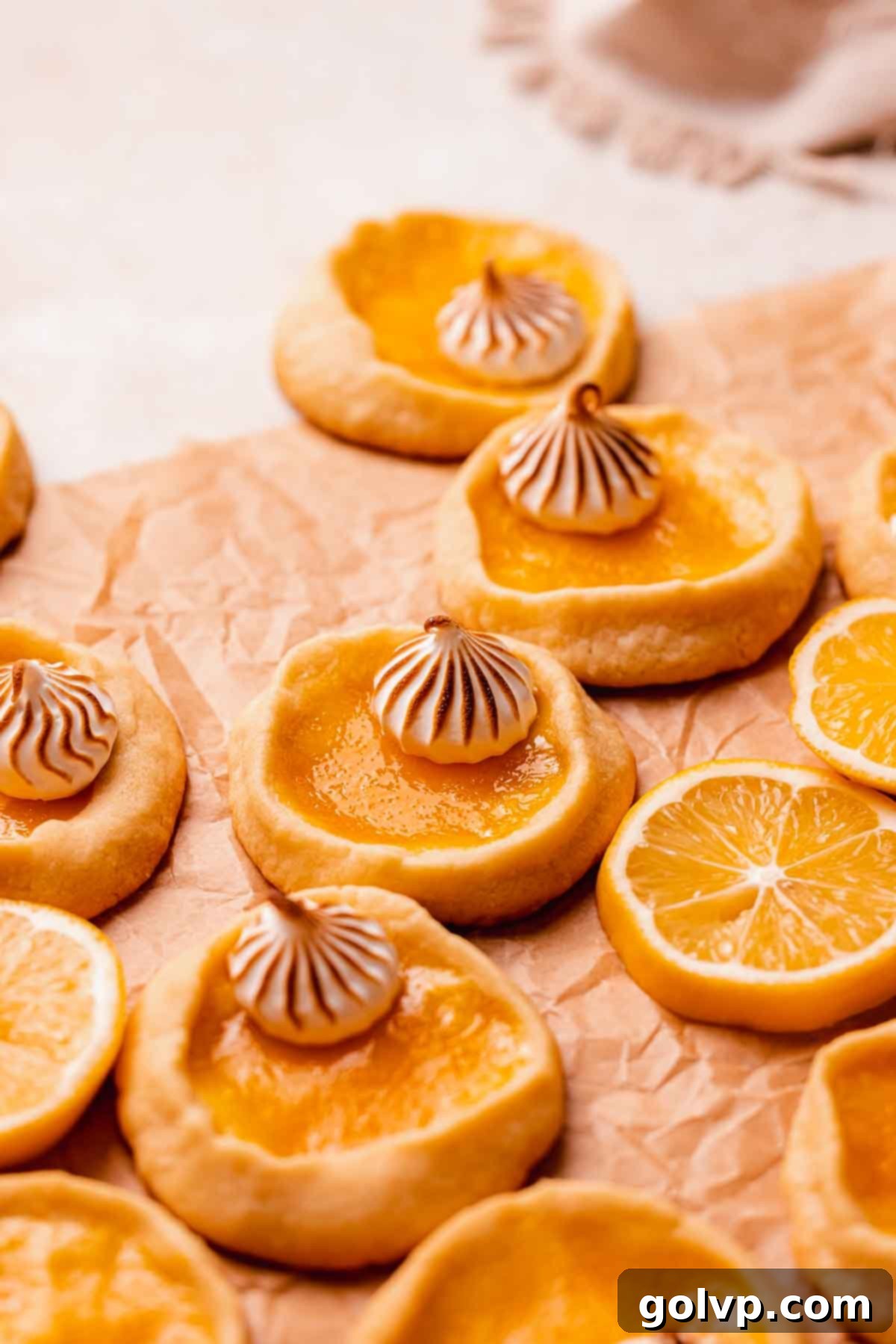
🍋 Why You’ll LOVE This Recipe
- Mini Lemon Meringue Pies in Every Bite: Imagine all the delightful elements of a classic lemon meringue pie, perfectly miniaturized into a convenient, handheld cookie. These individual portions are not only charming but also make serving and enjoying a breeze, perfect for gatherings or a personal indulgence.
- Perfectly Balanced Tangy, Zesty, and Smooth Lemon Filling: Our lemon filling is akin to a luxurious lemon bar filling – incredibly smooth, bursting with bright lemon flavor, and possessing just the right amount of tanginess to perfectly cut through the cookie’s sweetness. It’s robust enough to hold its shape beautifully within the shortbread cup, ensuring every cookie is a delightful miniature pie experience.
- Cloud-Like Toasted Swiss Meringue: Each cookie is crowned with a generous dollop of light, airy, and fluffy Swiss meringue. Unlike raw meringues, Swiss meringue is more stable and pasteurized, offering a safe and delightfully marshmallow-like topping. A quick kiss from a kitchen torch gives it that signature golden-brown, toasted finish, adding a visual appeal and a delicate caramelization of flavor.
- Incredible Textural Variety: From the crisp yet tender shortbread base to the silky lemon filling and the soft, pillowy meringue, these cookies offer an exciting array of textures in every single bite. This multi-layered experience makes them far more interesting and satisfying than your average cookie.
- Impressive Yet Achievable: While these cookies look incredibly sophisticated, the recipe is broken down into manageable steps, making them surprisingly accessible for home bakers of all skill levels. Impress your friends and family with a dessert that looks like it came from a high-end bakery.
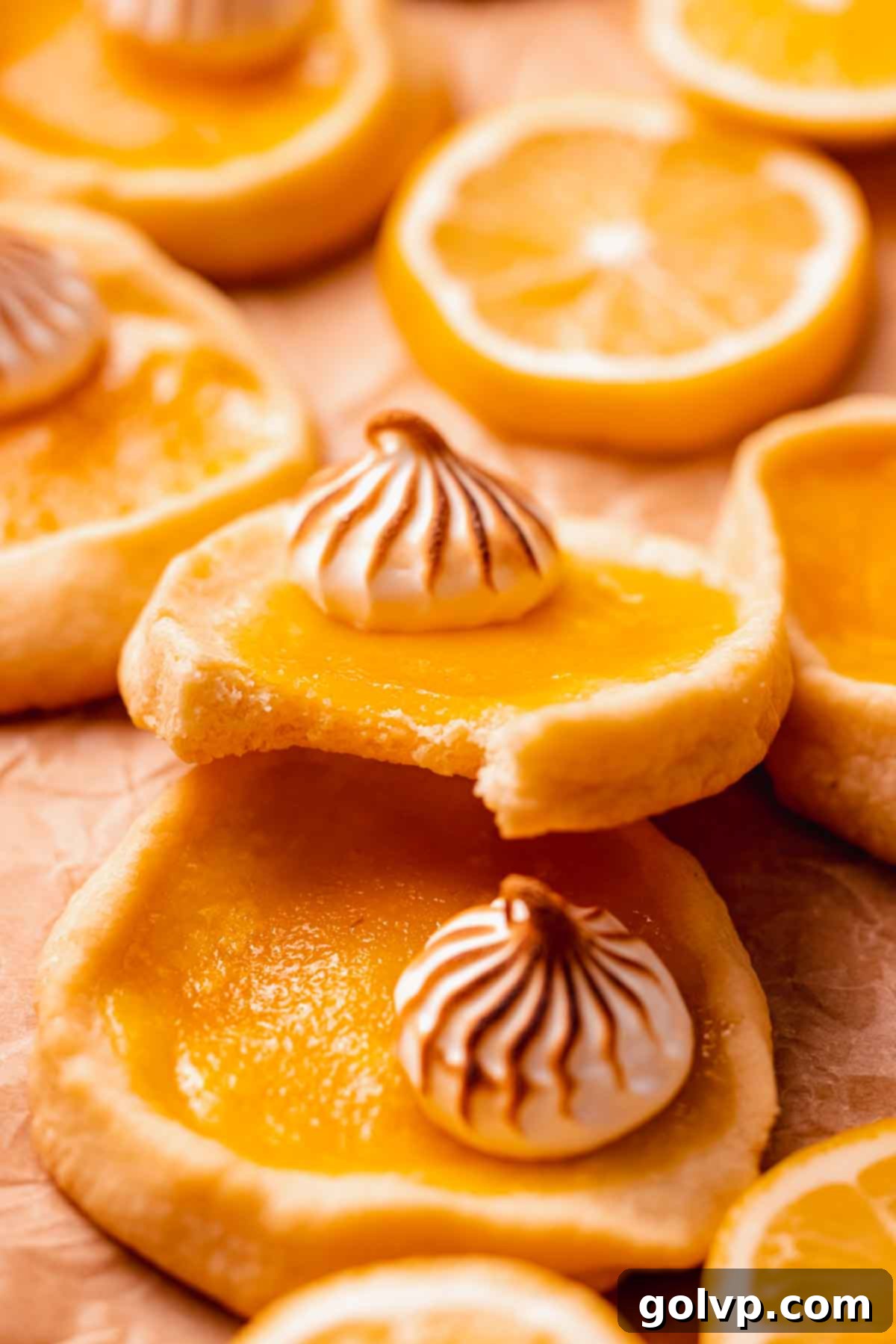
📝 Key Ingredients for Success
Read through for all the tips you will need for success!
Full steps and ingredients in recipe card below.
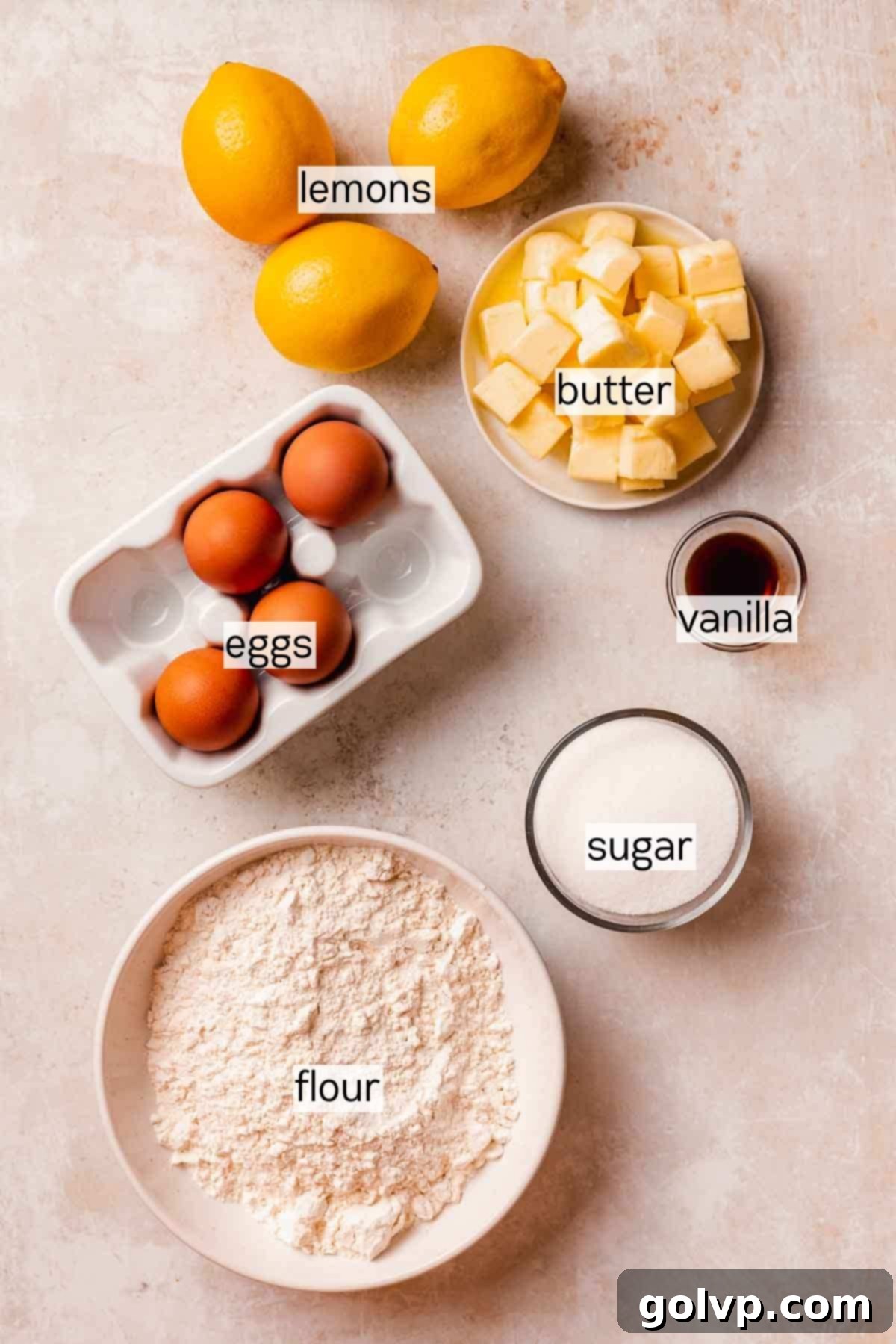
- Lemons: Fresh lemons are absolutely essential for the vibrant, authentic flavor of these cookies. You’ll need approximately 2-3 standard lemons to get enough zest and juice for both the shortbread and the filling. I highly recommend using regular lemons over Meyer lemons for this recipe; their higher acidity provides a super tangy filling that perfectly balances the sweetness of the meringue and shortbread. While Meyer lemons are delicious, they tend to yield a much sweeter cookie, which might be less balanced for some palates.
- Eggs: This recipe makes clever use of both egg yolks and egg whites. The rich egg yolks contribute to the tender, golden shortbread and the creamy, emulsified lemon filling, giving it a beautiful bright yellow hue. The egg whites are reserved for creating the light and airy Swiss meringue topping. Ensure your eggs are at room temperature for optimal mixing and whipping results.
- Butter: As the star of our buttery shortbread, high-quality unsalted butter makes a significant difference. Using real butter ensures the perfect consistency, a rich flavor, and that delightful melt-in-your-mouth texture. Make sure your butter is softened to room temperature for proper creaming with the sugar, which is crucial for a light and airy cookie dough.
- All-Purpose Flour: Accuracy in measuring flour is paramount for the perfect shortbread texture. I strongly advise weighing your flour using a kitchen scale for the most consistent and accurate results. If you don’t have a scale, properly measure by fluffing the flour in its bag, gently spooning it into a measuring cup until overflowing, then leveling off the excess with the flat edge of a knife, without packing it down. Over-measured flour can lead to a dry, crumbly dough, while under-measured flour can make it too soft.
- Granulated Sugar: Sugar plays multiple roles here – sweetening the cookie base, balancing the lemon’s tartness in the filling, and providing structure and sweetness to the meringue. Rubbing the lemon zest into the sugar is a key technique to infuse maximum lemon flavor.
- Vanilla Extract: Pure vanilla extract enhances the overall flavor profile, adding warmth and depth to both the shortbread and the meringue. It acts as a lovely counterpart to the bright lemon notes.
- Sea Salt: A touch of sea salt in each component (shortbread, filling, meringue) helps to amplify and balance all the flavors, preventing the cookies from tasting overly sweet and bringing out the best in the lemon.
- Cream of Tartar: This ingredient is crucial for the Swiss meringue. It helps stabilize the egg whites, ensuring they whip up to stiff, glossy peaks and remain stable, preventing weeping or collapse.
Don’t let any leftover lemons go to waste! Use them to make my popular gooey lemon butter cake for another amazing dessert. Or, for a quick and easy option, my homemade lemon curd is absolutely delectable and versatile.
👩🍳 How to Make Lemon Meringue Pie Cookies
Shortbread Cookie Dough Step by Step
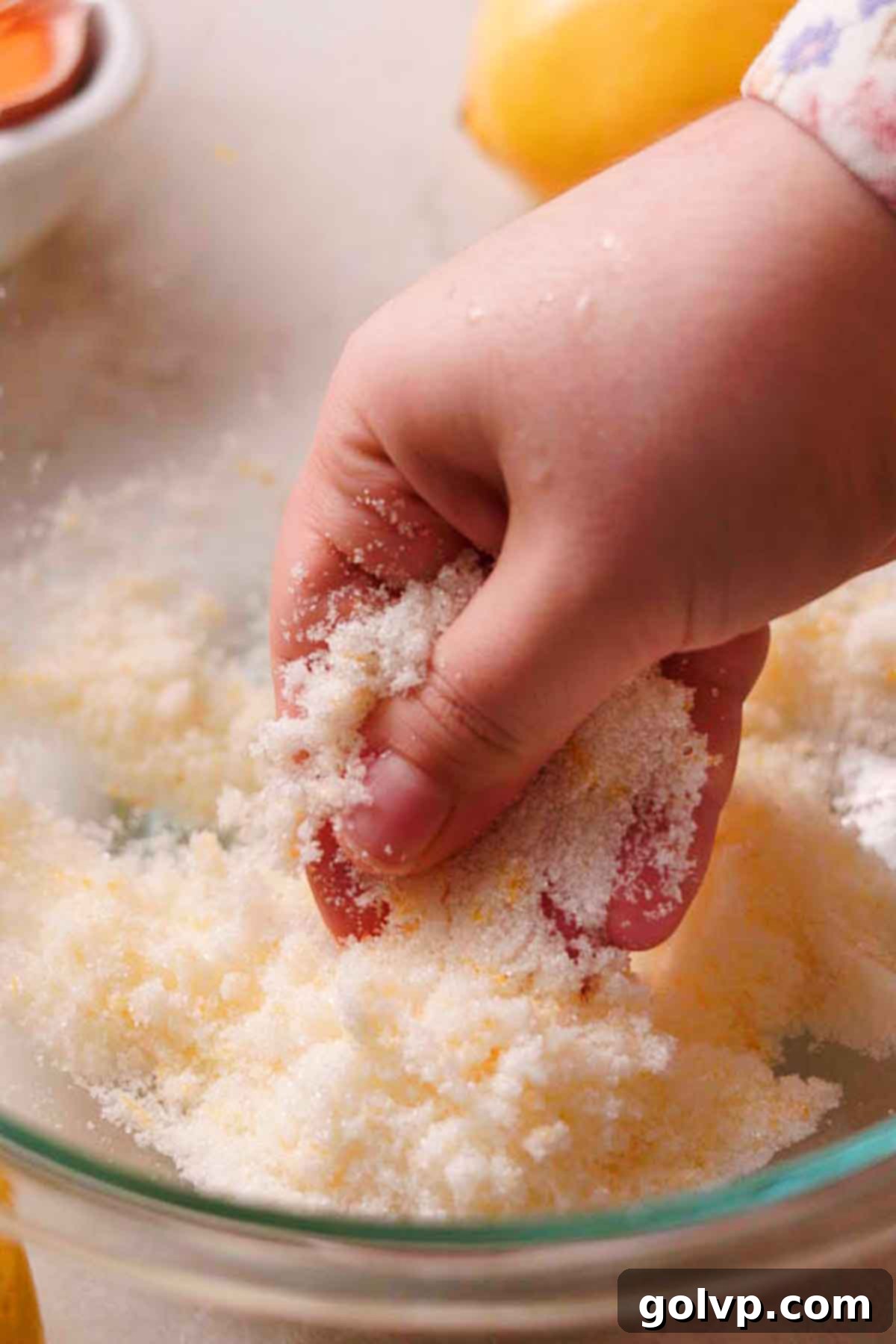
Step 1: Infuse the Sugar with Lemon Zest. In a large mixing bowl or the bowl of a stand mixer, add the granulated sugar. Finely grate the zest of one lemon directly into the sugar. Use your fingers to vigorously rub the lemon zest into the sugar for a minute or two. This vital step releases the fragrant essential oils from the lemon zest, infusing the sugar with intense lemon flavor, making it incredibly aromatic and slightly moist. This simple technique significantly boosts the lemon essence in your cookies.
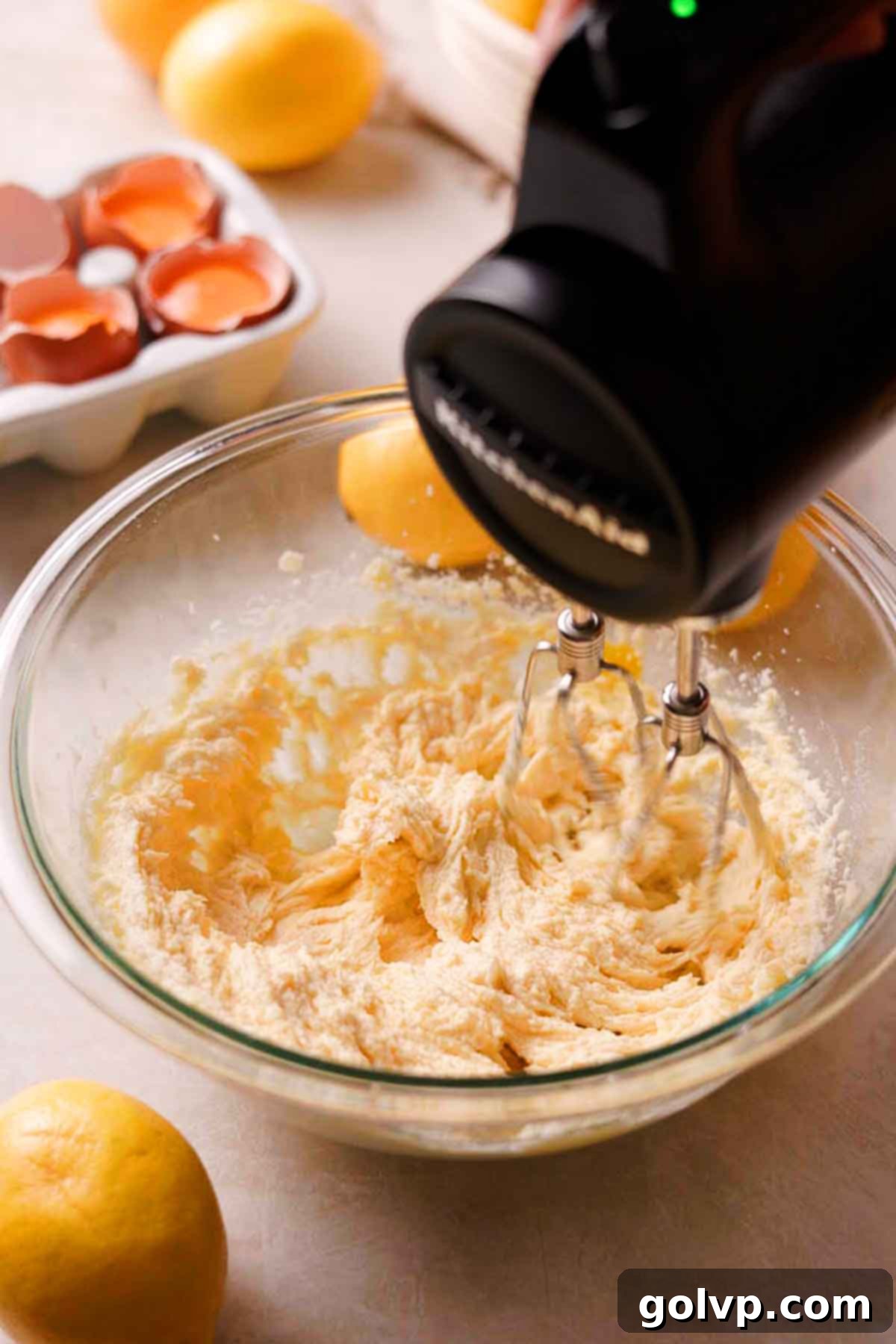
Step 2: Cream Butter, Egg, and Vanilla. Add the softened unsalted butter to the fragrant lemon sugar. Using an electric mixer (stand mixer or hand mixer), beat the mixture on medium speed until it becomes light, fluffy, and creamy, typically taking 2-3 minutes. This creaming process incorporates air, contributing to the shortbread’s tender texture. Next, add the large egg yolk and pure vanilla extract. Continue to beat until thoroughly combined, ensuring you scrape down the sides and bottom of the bowl frequently to incorporate all ingredients evenly.
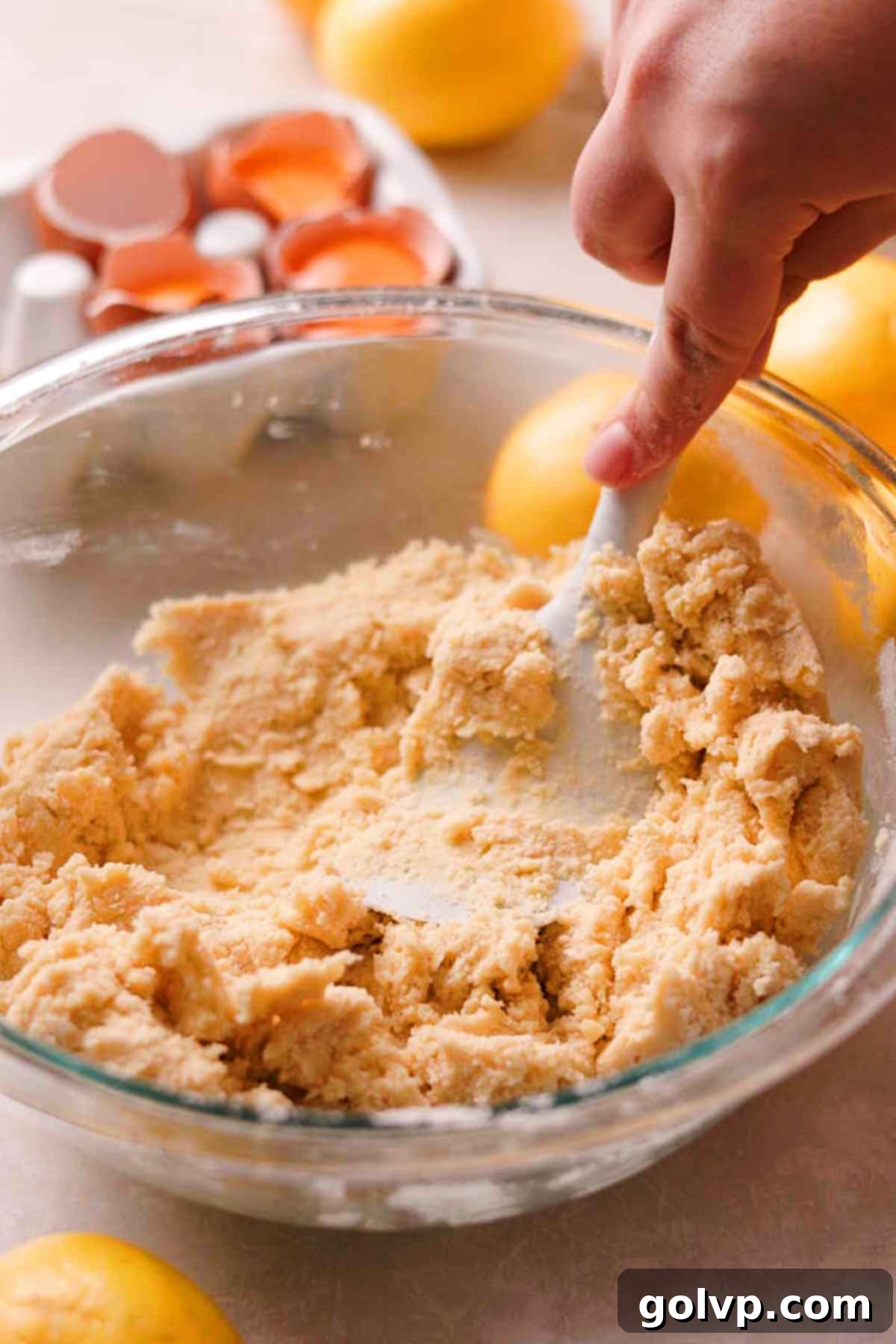
Step 3: Form the Dough. Add the sea salt to the bowl. Sift the all-purpose flour directly into the wet ingredients. Using a rubber spatula or wooden spoon, gently mix and fold the ingredients until they just come together to form a soft, buttery, and pliable dough. Be careful not to overmix, as this can develop the gluten in the flour and result in tough cookies. The dough should be smooth and cohesive. Once the dough is ready, use a 1 ½ tablespoon cookie scoop to portion out individual cookie dough balls. Roll each portion into a smooth ball between your palms. Line a baking sheet with parchment paper, which prevents sticking and ensures even baking.
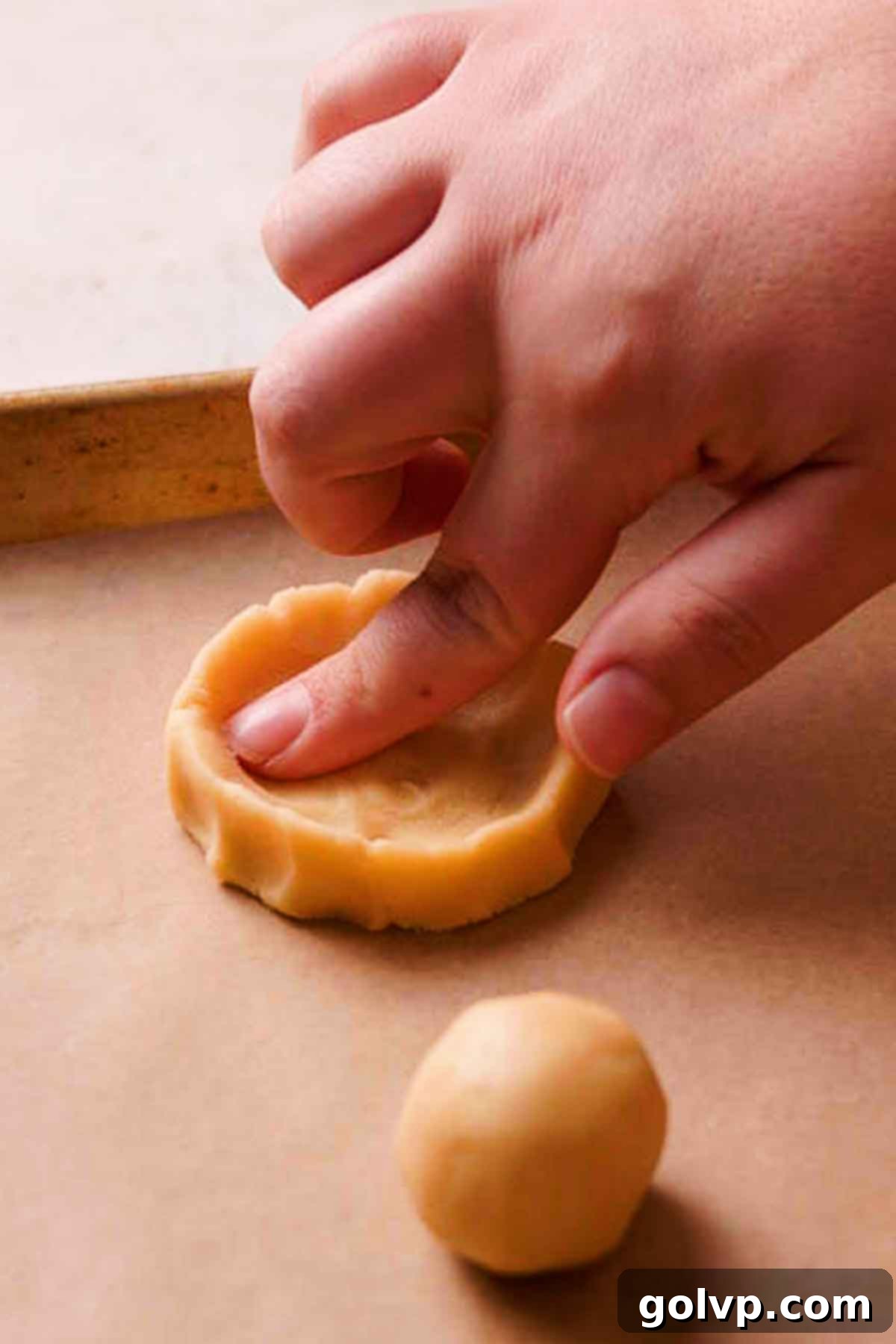
Step 4: Shape and Chill the Cookies. Take each rolled cookie dough ball and gently press your thumb into the center to create an indent. Then, carefully press the inside down and pinch the edges of the cookie up around the indent to create a shallow, tart-like cup shape. This cup will hold the delicious lemon filling. Repeat this process with all the remaining cookie dough balls, placing them evenly spaced on your prepared baking sheet(s). Once shaped, transfer the baking sheet(s) with the cookie dough into the freezer to chill for at least 15-20 minutes while you prepare the lemon filling. Chilling the dough is crucial for preventing the cookies from spreading too much in the oven and helps them maintain their shape.
Lemon Filling Step by Step
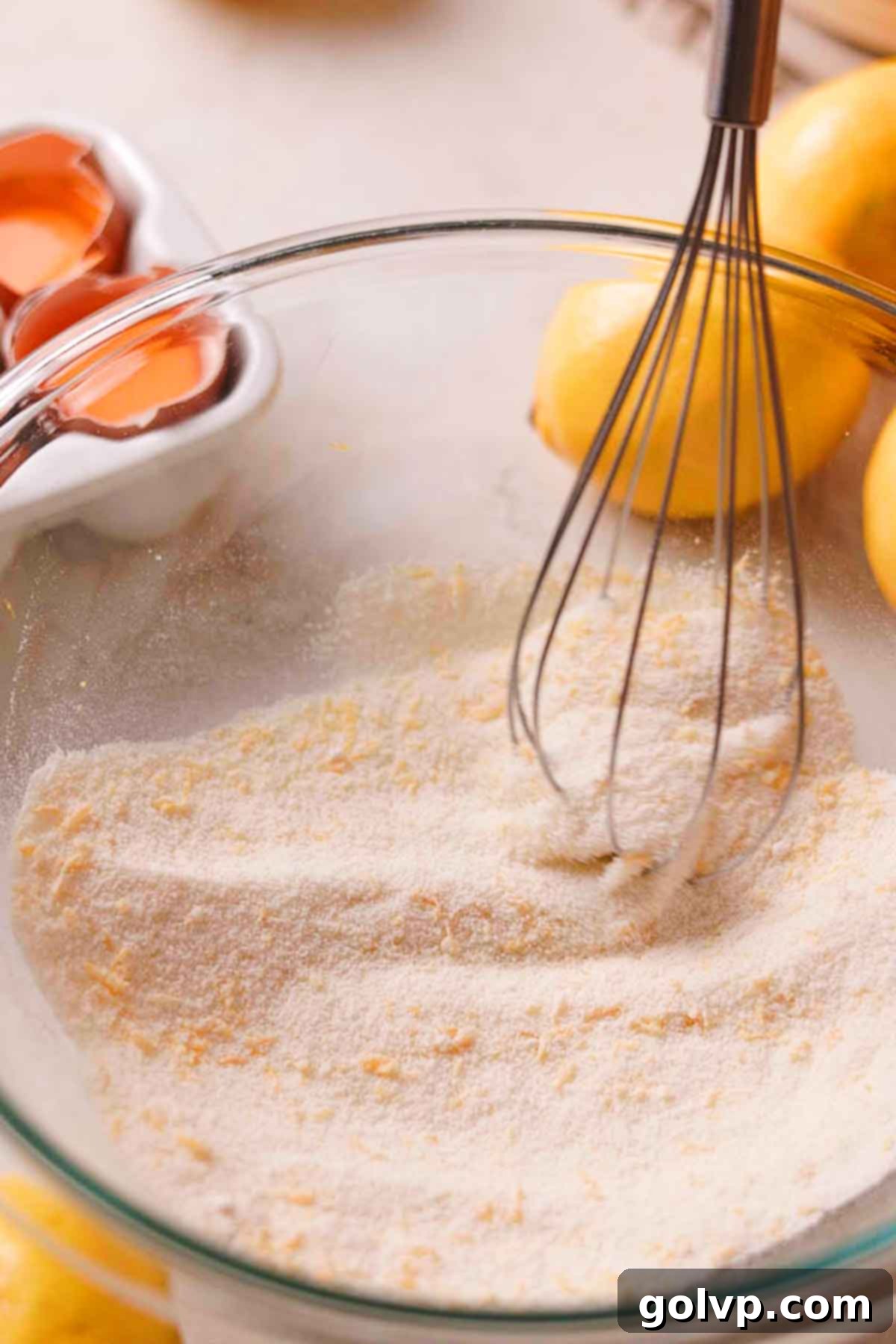
Step 1: Combine Dry Ingredients and Zest. In a medium or large mixing bowl, combine the granulated sugar, a pinch of sea salt, and the zest of another lemon. Again, take a moment to rub the lemon zest into the sugar with your fingers. This ensures maximum flavor extraction and a beautifully aromatic filling. Then, add the all-purpose flour and whisk thoroughly to break apart any lumps, ensuring a smooth base for your lemon filling.
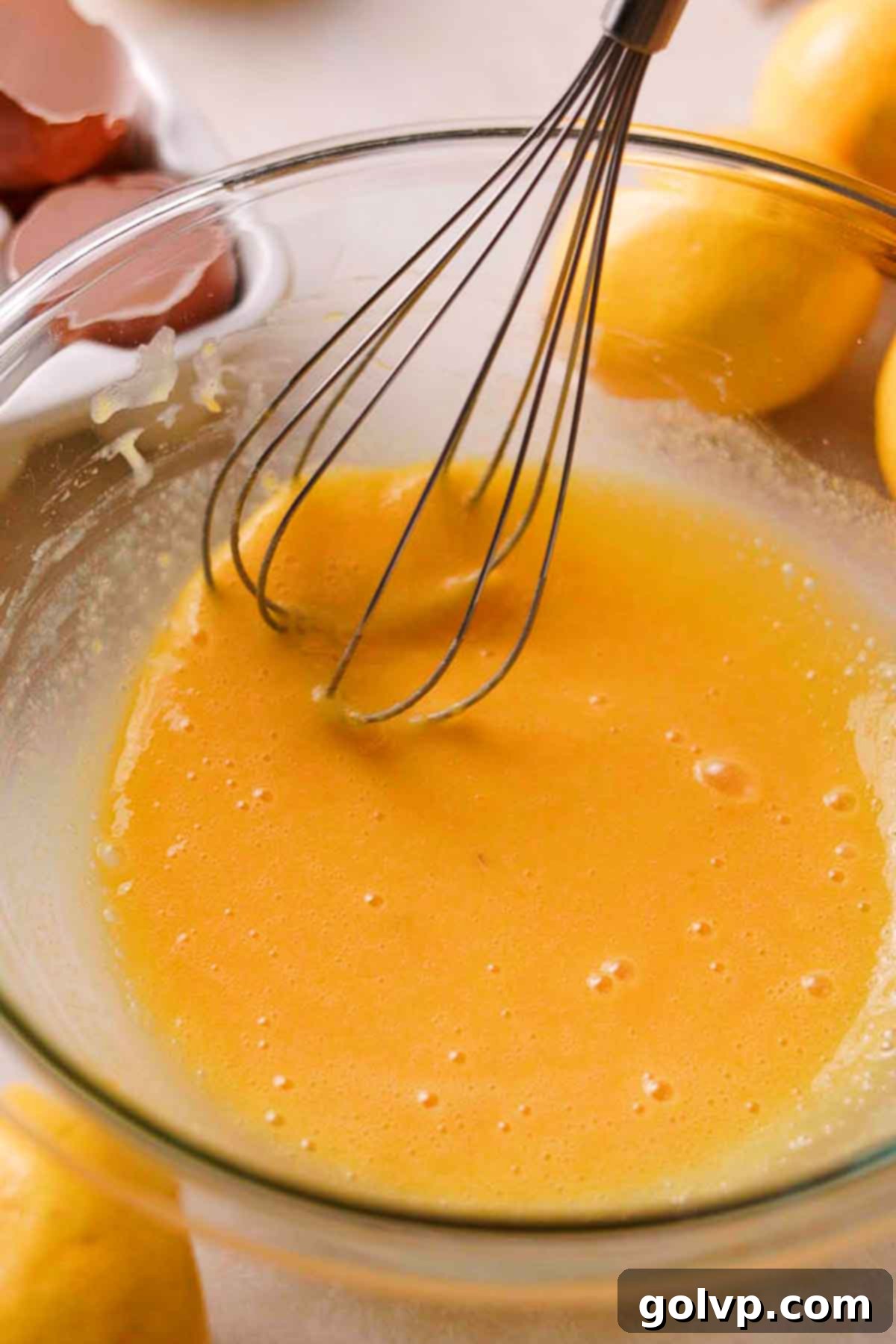
Step 2: Add Wet Ingredients. To the dry mixture, add the egg yolks and the freshly squeezed lemon juice. Whisk everything together vigorously until the mixture is completely smooth and well combined, with no streaks or lumps. The filling should be a beautiful, vibrant yellow and have a consistency similar to a thin custard. This ensures a uniform and luscious texture once baked.
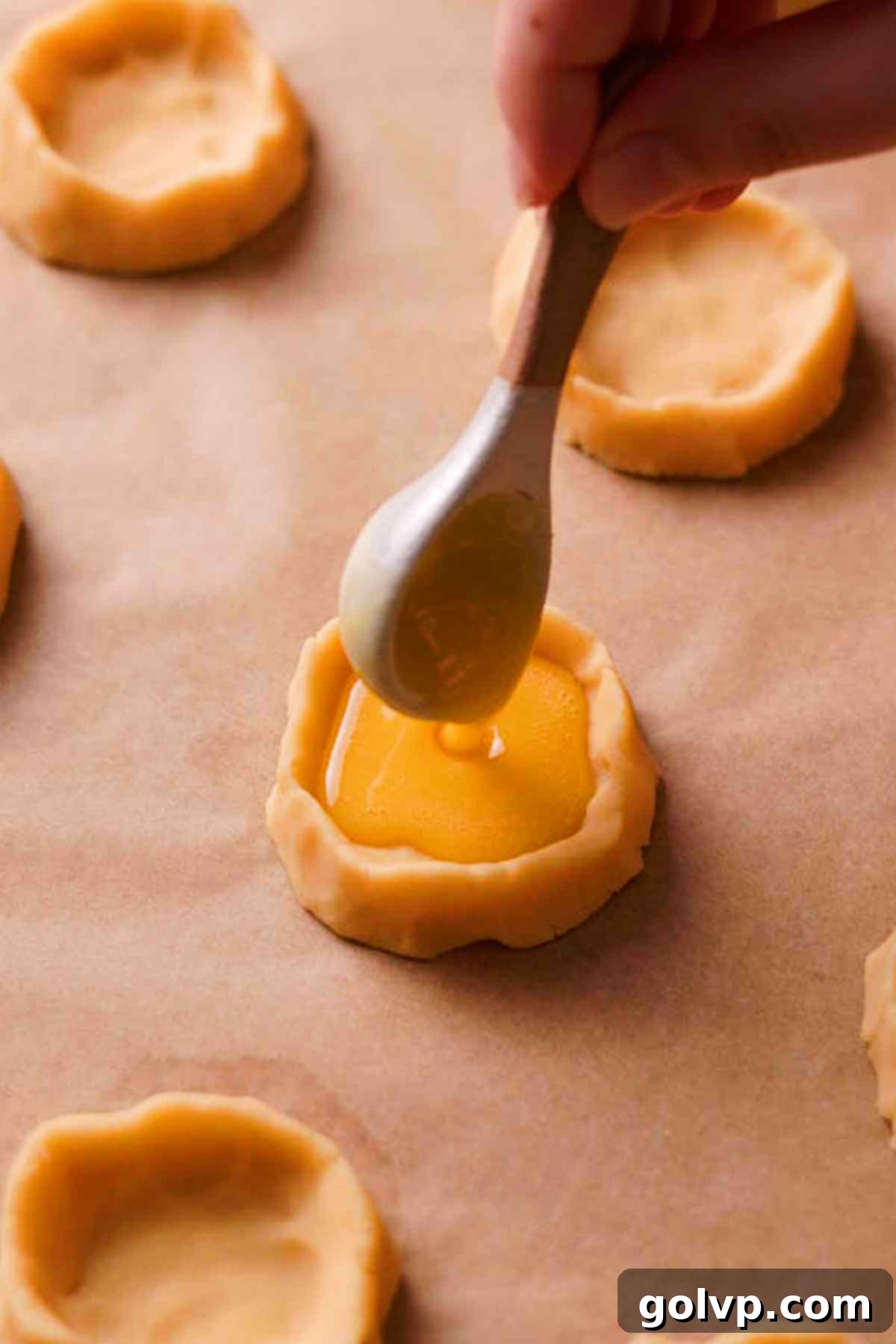
Step 3: Fill and Bake. Retrieve the chilled, shaped cookie dough from the freezer. Arrange the cookies on a parchment-lined or non-stick baking sheet, ensuring there’s about 2 inches of space between each cookie to allow for even baking. Carefully pour or spoon approximately 1 to 2 teaspoons of the prepared lemon filling into the centers of each cookie cup. Be careful not to overfill, as this could cause the filling to spill over during baking.
Bake the cookies in a preheated oven at 355°F (180°C) for 12-14 minutes, or until the edges of the shortbread are lightly golden brown and the lemon centers appear set and no longer jiggly. The baking time may vary slightly depending on your oven. Once baked, remove the cookies from the oven and let them cool on the baking sheet for a few minutes to firm up before carefully transferring them onto a wire cooling rack or plate to cool completely. Cooling fully is essential before adding the meringue.
Swiss Meringue Step by Step
Step 1: Prepare a Double Boiler. Find a medium saucepan and a heat-safe mixing bowl (preferably stainless steel or glass) that fits snugly on top of the saucepan without touching the bottom of the pan. Add 1-2 inches of water to the bottom of the saucepan and place it on your stovetop over medium-low heat to bring the water to a gentle simmer. The bowl should rest above the simmering water, heated by the steam, not directly by the water itself.
Step 2: Clean the Meringue Bowl. Before adding any ingredients, wipe the inside of your heat-safe bowl thoroughly with a paper towel dampened with a tiny bit of white vinegar or lemon juice. This crucial step helps to remove any residual greasy fingerprints or microscopic fat particles, which can prevent the egg whites from whipping up properly and achieving stiff peaks. A perfectly clean, fat-free bowl is essential for successful meringue.
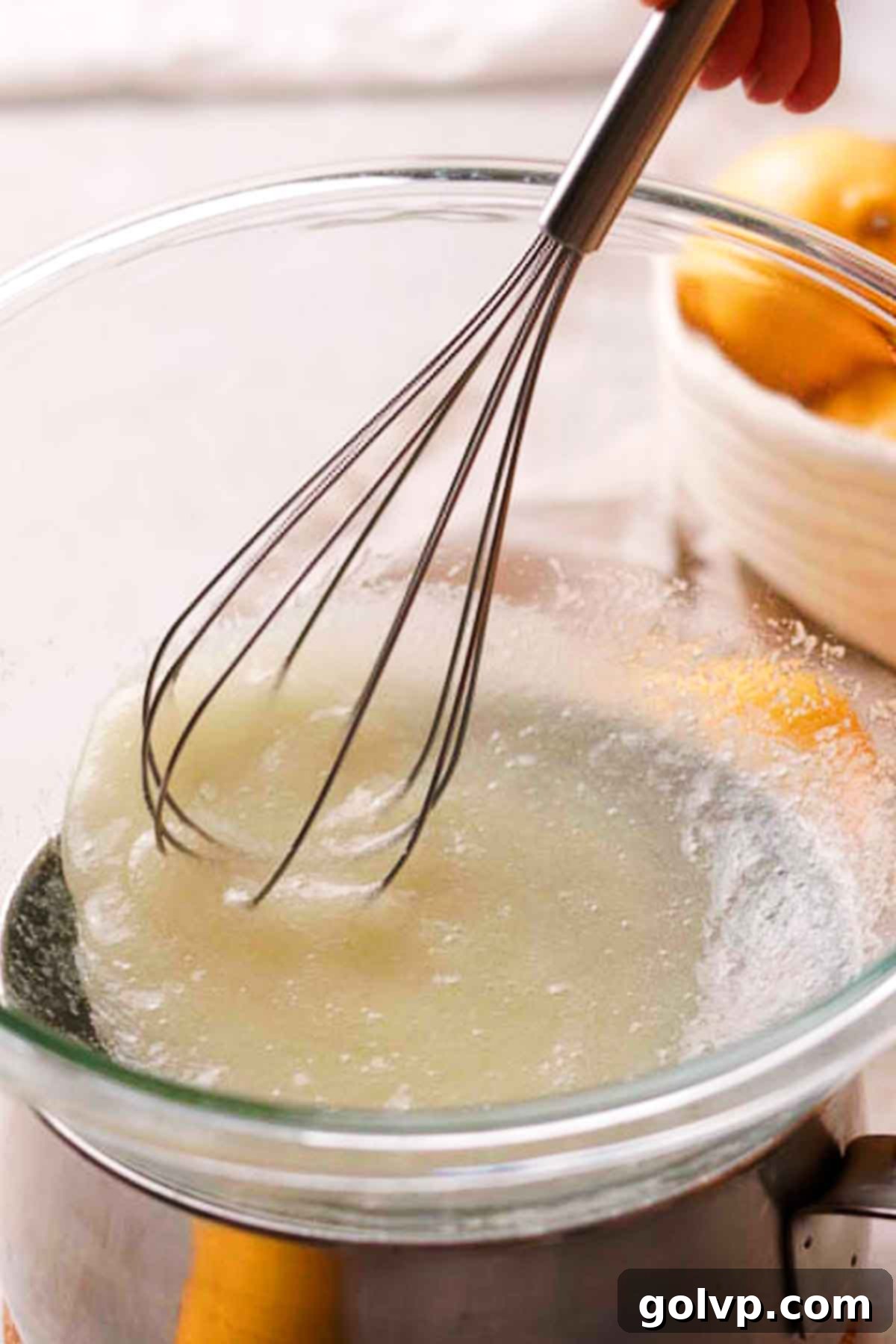
Step 3: Combine and Heat Meringue Ingredients. Into the impeccably clean, heat-safe bowl, add the large egg whites (ensure there are absolutely no traces of egg yolk, as yolk fat will ruin your meringue), granulated sugar, sea salt, and cream of tartar. Whisk these ingredients together by hand until they are well combined. Place the bowl securely on top of the saucepan with simmering water, ensuring the bottom of the bowl does not touch the water. Stir the mixture continuously or occasionally with a whisk over the simmering water.
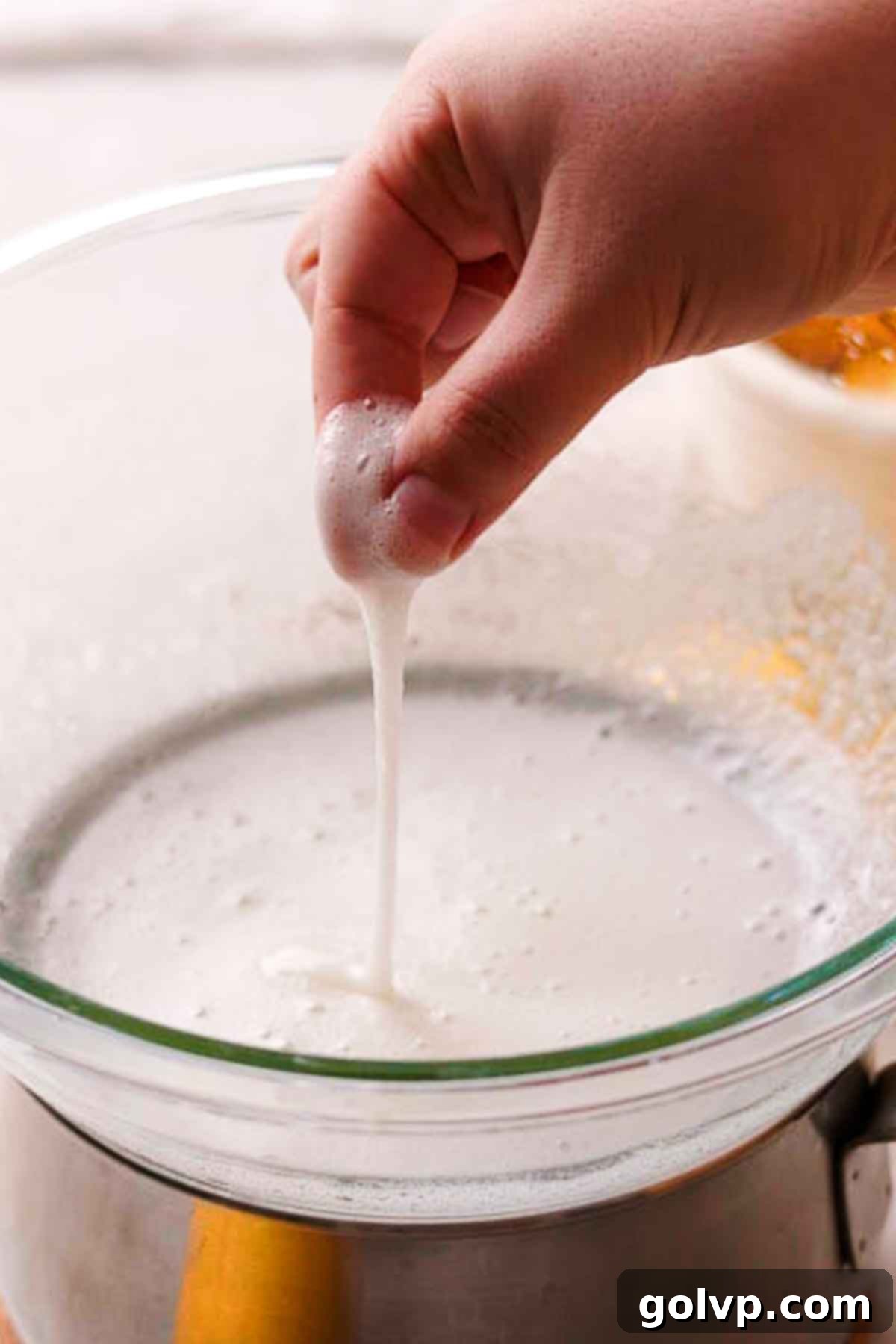
Step 4: Dissolve the Sugar. Continue stirring the egg white mixture over the simmering water until all the granulated sugar has completely dissolved. You can test this by rubbing a small amount of the mixture between your fingers; it should feel perfectly smooth, not grainy. Simultaneously, the mixture should feel very warm to the touch, reaching a temperature of approximately 175°F (79°C). This heating step pasteurizes the egg whites, making the meringue safe to eat and creating a much more stable meringue that is less prone to weeping. This usually takes about 5-7 minutes.
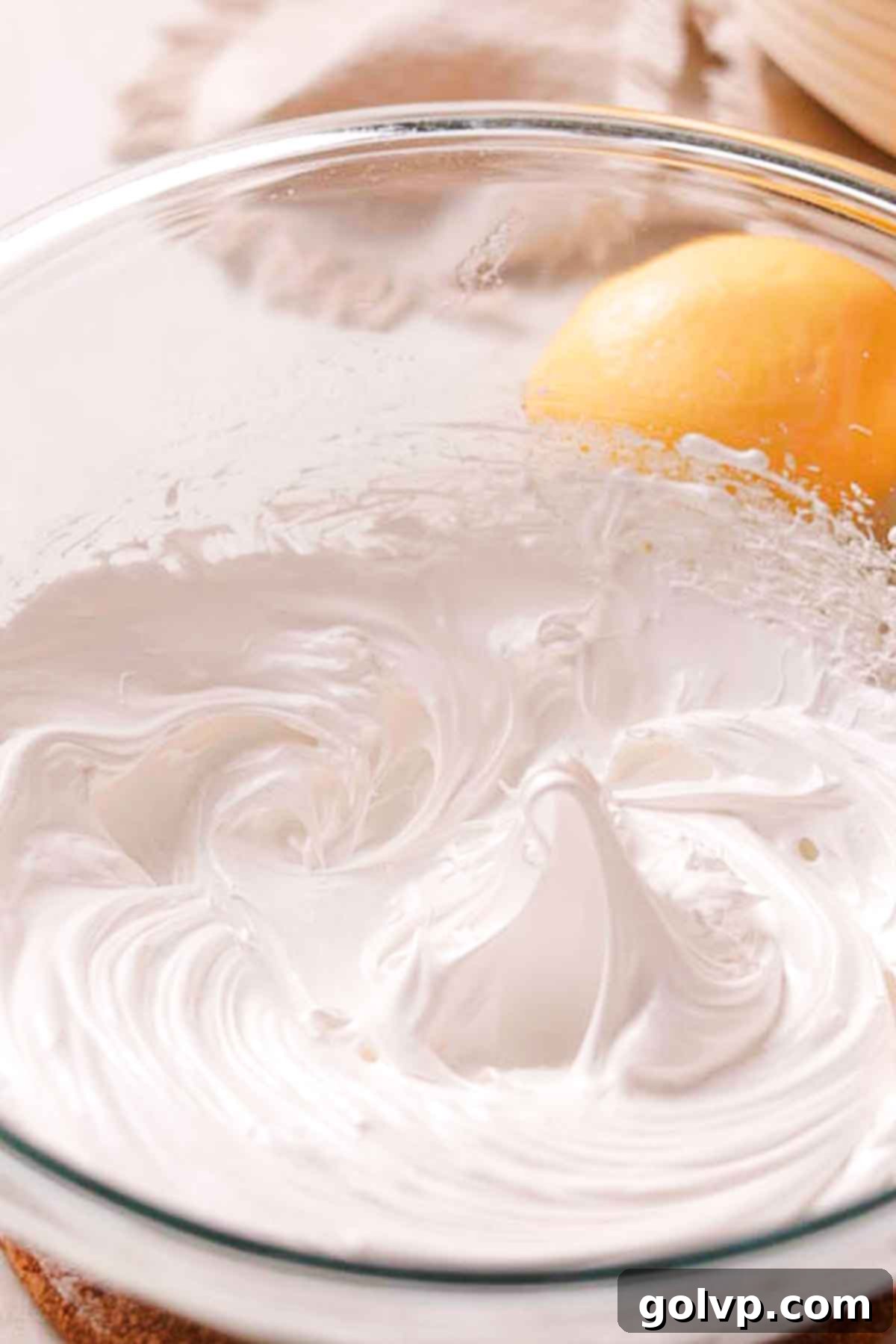
Step 5: Whip to Stiff Peaks. Once the sugar is dissolved and the mixture is warm, turn off the heat. Using oven mitts, carefully remove the bowl from the saucepan and transfer it to your stand mixer (or use a hand mixer). Immediately add the pure vanilla extract to the hot egg white and sugar mixture. Using the whisk attachment, begin whipping the egg whites on medium-high speed. Continue whipping until the meringue becomes thick, glossy, and holds stiff peaks. When you lift the whisk, the meringue should stand straight up and hold its shape firmly without collapsing. The bowl should also feel cool to the touch, indicating the meringue has fully cooled during whipping.
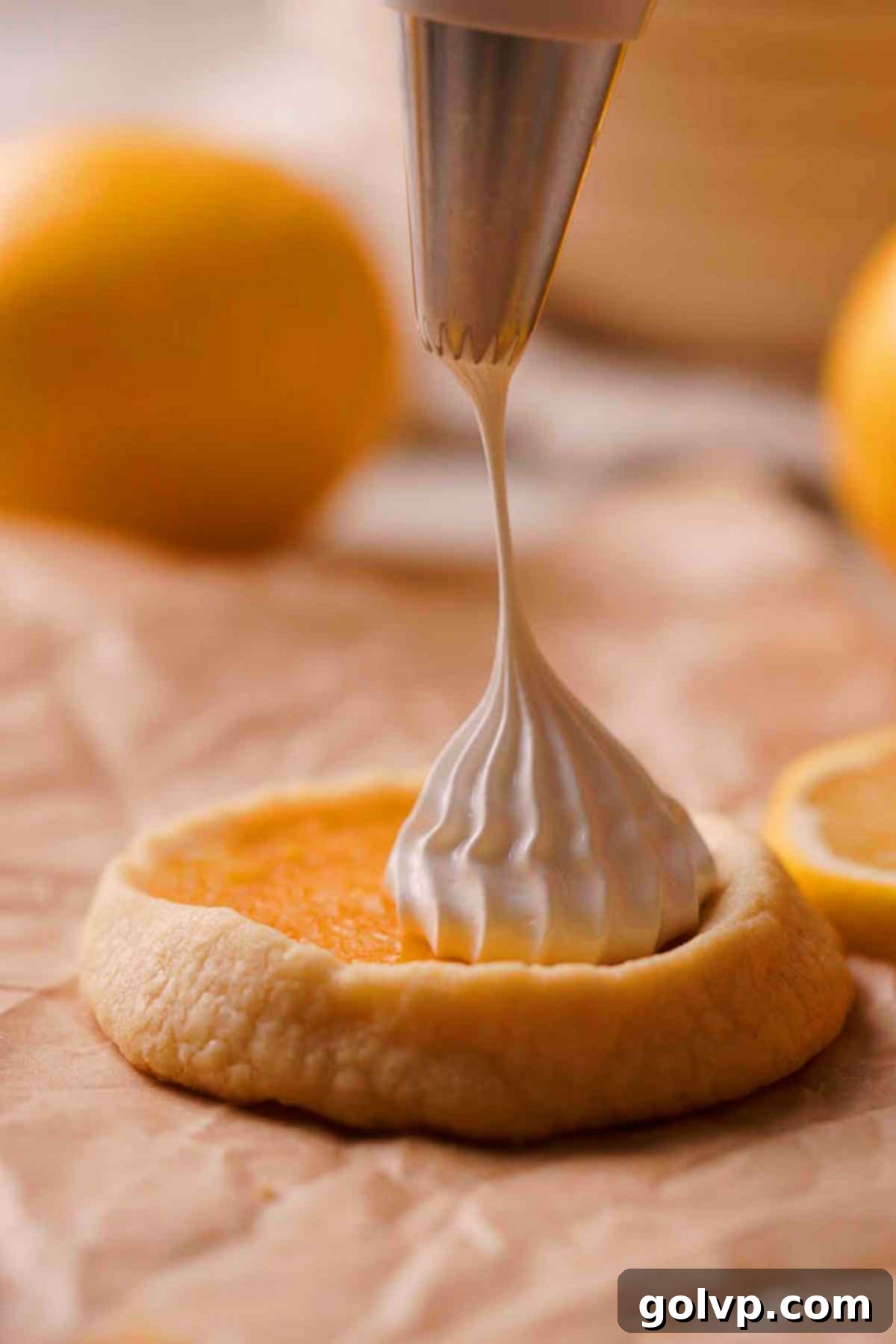
Step 6: Pipe and Torch the Meringue. Transfer the freshly whipped Swiss meringue into a piping bag fitted with a 4B piping tip, or any large open star piping tip. Work quickly, as meringue is best piped immediately. Pipe a generous, beautiful dollop of meringue onto the center of each completely cooled lemon shortbread cookie. For that classic lemon meringue pie finish, use a kitchen torch to lightly brown the peaks of the meringue. This adds a lovely visual appeal and a delicate toasted flavor. These cookies are best enjoyed the same day they are made and the meringue is piped. Due to the meringue topping, they must be stored in the refrigerator.
✔️ Expert Lemon Meringue Cookie Tips for Perfection
- Don’t Skip Rubbing Lemon Zest and Sugar: This isn’t just a fancy step; it’s a flavor powerhouse! By rubbing the zest into the sugar with your fingertips, you effectively release and infuse the fragrant essential oils of the lemon into the sugar crystals. This process creates a much more intense, brighter, and overall deeper lemon flavor throughout your cookies, making them truly stand out. It’s a sensory experience in itself!
- Always Use Room Temperature Ingredients: This applies to butter and eggs. Room temperature butter creams beautifully with sugar, incorporating air for a tender shortbread. Cold butter will result in a dense, crumbly dough. Room temperature eggs emulsify better into mixtures, leading to a smoother, more consistent dough and filling. For the meringue, while the whites are heated, starting with room temperature whites can sometimes aid in faster whipping.
- Mix the Cookie Dough Well, But Avoid Overmixing! It’s a fine balance. You need to mix the shortbread dough until all ingredients are evenly combined and the dough is cohesive. If the dough isn’t mixed sufficiently, the butter might not be fully incorporated, leading to weak cookie walls that could collapse in the oven, causing your precious lemon filling to leak out. However, overmixing the dough will develop the gluten in the flour, resulting in tough, chewy cookies instead of the desired tender, crumbly shortbread texture. Mix until just combined and smooth.
- Ensure a Spotlessly Clean Meringue Bowl: This tip is non-negotiable for successful Swiss meringue! Any trace of fat—whether from greasy fingerprints, residual dish soap, or a speck of egg yolk—will prevent the egg whites from whipping up to stiff peaks. Wiping the bowl with white vinegar or lemon juice acts as a degreaser, ensuring the egg whites can fully aerate and stabilize.
- Accurate Flour Measurement is Key: Especially for shortbread, precise flour measurement dictates the final texture. Too much flour will lead to dry, stiff cookies, while too little can make them overly soft and prone to spreading. Always weigh your flour for accuracy, or use the spoon-and-level method if you don’t have a scale.
- Chill the Cookie Dough Thoroughly: Don’t rush the chilling process. Freezing the shaped shortbread cups for at least 15-20 minutes before baking helps to solidify the butter, which prevents the cookies from spreading excessively in the oven and helps them maintain their crisp, defined edges, ensuring your lemon filling stays contained.
- Use a Thermometer for Swiss Meringue: While the “rub between fingers” test works, a food thermometer provides absolute precision for heating the egg white and sugar mixture. Reaching 175°F (79°C) ensures the egg whites are pasteurized and the sugar is fully dissolved, leading to the most stable and safest meringue.
- Don’t Overfill the Cookie Cups: A careful hand is needed when spooning the lemon filling into the shortbread cups. Overfilling can cause the filling to bubble over the sides during baking, making your cookies messy and potentially sticky. Stick to 1-2 teaspoons per cookie.
- Cool Cookies Completely Before Meringue: Ensure your baked lemon shortbread cookies are entirely cool before piping on the Swiss meringue. Piping meringue onto warm cookies will cause the meringue to melt and deflate, ruining the beautiful presentation and texture.
- Torch the Meringue Just Before Serving: While meringue holds up in the fridge, the toasted finish is best when fresh. Torch the meringue shortly before serving for the most appealing golden color and slightly caramelized flavor.
🥄 Make Ahead and Storage
These delightful lemon meringue pie cookies are truly at their best when eaten fresh, especially on the same day the meringue is added. The light and airy meringue topping is sensitive to moisture and refrigeration. If stored, the meringue may begin to “weep,” releasing a sugary syrup, which can alter its texture. Therefore, for optimal enjoyment and presentation, serving them freshly assembled is highly recommended.
If you have leftovers or plan to prepare them in advance, the baked cookies with their lemon filling (but without the meringue) can be stored in an airtight container at room temperature for up to 3 days, or in the refrigerator for up to a week. However, once the meringue topping is added, the cookies must be stored in the refrigerator due to the egg whites. They will keep well in the fridge for 1-2 days, but, as mentioned, the meringue’s texture may change and it might start to seep a sugary liquid. For the best experience, only pipe and torch the meringue just before serving.
To make these lemon meringue pie cookies ahead of time and simplify your baking day, I highly recommend preparing and shaping the shortbread cookie dough in advance. You can freeze the unbaked, shaped cookie dough balls (without the filling) on a baking sheet until solid, then transfer them to a freezer-safe bag or container. They can be stored in the freezer for 1-2 months. When you’re ready to bake, you can bake them directly from frozen (adding a few extra minutes to the baking time) or let them thaw slightly before adding the filling. The lemon filling and the Swiss meringue topping should always be made fresh on the day you plan to bake and serve the cookies to ensure the highest quality and best texture.

❔ Why Make Swiss Meringue Over Regular Meringue?
When it comes to toppings like the one for these lemon meringue cookies, I am a huge advocate for Swiss meringue. There are several compelling reasons why it’s superior to a traditional (French) meringue, especially for this particular recipe.
Firstly, Swiss meringue is significantly more stable. Unlike French meringue, which is simply whipped raw egg whites and sugar, Swiss meringue involves gently heating the egg whites and sugar over a double boiler until the sugar dissolves and the mixture reaches a safe temperature. This cooking process partially denatures the egg proteins and fully dissolves the sugar, resulting in a much stronger, more resilient meringue structure. This stability means it’s far less likely to collapse, deflate, or “weep” (seep sugary syrup) over time, which is a common issue with raw meringues, especially when refrigerated.
Secondly, and critically important for food safety, the heating process involved in making Swiss meringue effectively pasteurizes the egg whites. By bringing the mixture up to 175°F (79°C), any potential harmful bacteria often found in raw eggs are eliminated, making the meringue safe to eat for everyone, including young children, pregnant individuals, and those with compromised immune systems. If you don’t have a food thermometer, you can test the temperature by carefully touching the egg white mixture with your fingers: it should feel very warm—almost hot—and completely smooth, without any grainy sugar crystals. After heating, you then whip it up to stiff peaks as you would with any meringue.
Finally, for this recipe, using Swiss meringue means you don’t need to bake the meringue on the cookies in the oven. Traditional meringue often requires baking to cook the egg whites, but baking these cookies twice would likely lead to overbaked shortbread and a dry filling. With Swiss meringue, you can simply pipe it on after the cookies have cooled and then give it a quick, beautiful toast with a kitchen torch, achieving that iconic golden-brown finish without further baking the entire cookie.
🍋 Why I Love to Rub Lemon Zest and Sugar Together for Lemon Desserts
This simple yet highly effective technique is my absolute favorite way to dramatically boost and elevate the natural lemon flavor in almost any lemon-infused baked good. It’s a game-changer! When you rub fresh lemon zest vigorously into granulated sugar with your fingers, you’re not just mixing them; you’re actively releasing the potent, fragrant essential oils that are trapped within the tiny cells of the lemon peel. These oils are packed with intense lemon flavor and aroma.
The friction and gentle pressure against the sugar crystals essentially “scrub” these oils out, transferring their vibrant essence directly into the sugar. This step is incredibly satisfying to do, and the moment you start, your kitchen will be filled with a truly beautiful, bright lemon scent. It’s an ultimate sensory play that engages both touch and smell, promising the deliciousness to come.
The result is a lemon-infused sugar that carries a much deeper and more complex lemon flavor than simply adding zest and sugar separately. This method truly creates the ultimate lemon meringue cookies, ensuring every component, from the shortbread to the filling, sings with bright, authentic lemon taste. I also swear by this method in my lemon white chocolate cookies, where it helps create the ultimate zesty and chewy cookie that explodes with citrus goodness.
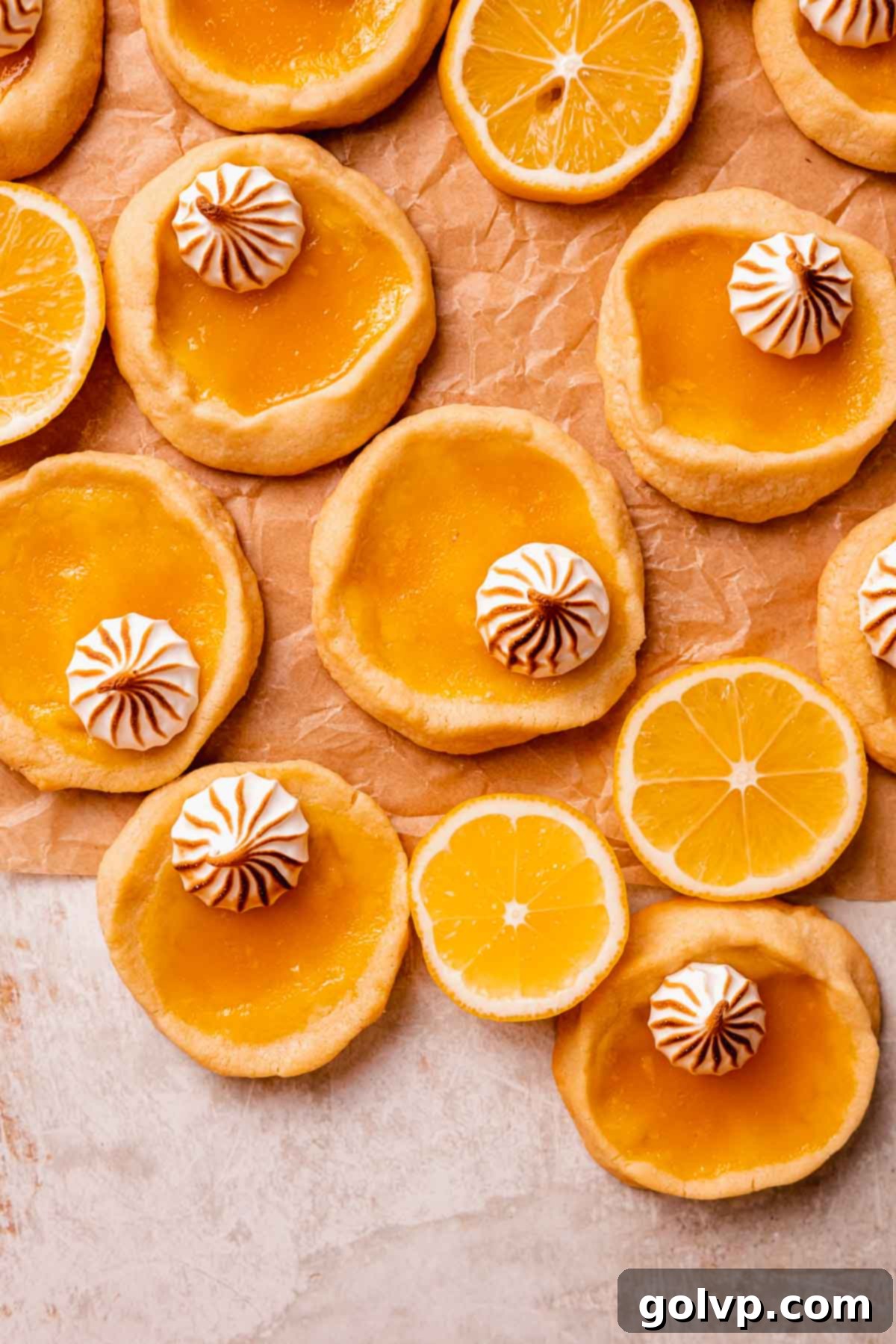
📖 Recipe FAQs
While I haven’t personally tested other citrus fruits for this specific recipe, it should theoretically work well for similar citrus like limes, especially for the filling. Limes will offer a distinct, slightly more floral tartness. You may need to adjust the quantity of limes, as they typically yield less juice than standard lemons, so be prepared to use more to get the required amount.
Preventing the filling from leaking is crucial for perfect lemon meringue cookies. The key lies in two main aspects: properly mixing and chilling your shortbread dough. First, ensure your shortbread dough is mixed evenly so the butter is thoroughly incorporated and the dough has a consistent structure. This creates strong “cookie walls” that won’t collapse. Second, and equally important, is chilling the shaped cookie dough in the freezer before baking. This solidifies the butter, making the dough more stable and less prone to spreading, thus keeping your lemon filling securely in its cup. I also highly recommend weighing the flour for the shortbread dough to achieve the perfect consistency, which directly impacts the sturdiness of the cookie base.
I strongly recommend using Swiss meringue for this recipe over traditional French meringue for a few key reasons. Firstly, the Swiss method involves gently heating the egg whites and sugar, which pasteurizes the egg whites, making them safe to consume without further baking – a significant food safety benefit. Secondly, Swiss meringue is much more stable and less prone to weeping or deflating compared to French meringue, especially when stored. Lastly, regular meringue often requires a baking step to cook the egg whites, which would mean baking your cookies twice. This would likely result in an overbaked, dry shortbread base and a potentially rubbery lemon filling. Swiss meringue allows you to pipe the delicious, stable topping onto your already baked and cooled cookies, then simply toast it with a kitchen torch for that beautiful golden finish.
While you technically *can* use bottled lemon juice, I highly discourage it for this recipe. Freshly squeezed lemon juice provides a bright, complex, and natural tang that bottled juice simply cannot replicate. Bottled lemon juice often contains preservatives and lacks the vibrant aroma and nuanced flavor essential for truly exceptional lemon desserts. For the best possible flavor in your Lemon Meringue Pie Cookies, always opt for fresh lemons.
A runny meringue is typically caused by one of two factors: either there was a trace of fat (like egg yolk or grease) in your mixing bowl or on your whisk, or the sugar was not completely dissolved during the heating process. Ensure your bowl and whisk are spotlessly clean (wiping with vinegar helps!), and confirm that the egg white-sugar mixture is heated sufficiently (to 175°F/79°C) and feels absolutely smooth when rubbed between your fingers before you begin whipping. Also, ensure you whip it long enough until it reaches firm, glossy, stiff peaks. Patience is key here!
🍪 More Related Recipes to Satisfy Your Sweet Cravings!
- Lemon White Chocolate Cookies
- Lemon Shortbread Cookies
- Lemon Posset
- Lemon Curd Cookies
Did you try this incredible recipe? I would absolutely love for you to rate this recipe and share your thoughts in the comments below! Your feedback helps other bakers. Don’t forget to share your beautiful creations on Instagram and tag @flouringkitchen. For more delicious recipe ideas and baking inspiration, be sure to follow me on Pinterest!
📖 Recipe
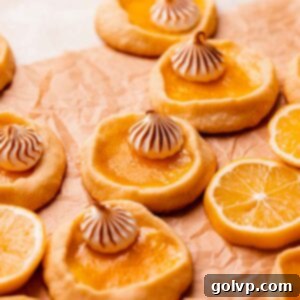
Lemon Meringue Pie Cookies
Mary
Pin Recipe
Shop Ingredients
Equipment
-
electric mixer
Ingredients
Shortbread Cookie Dough
- ¾ cup granulated sugar
- 1 lemon zested
- 1 cup unsalted butter softened
- ½ teaspoon sea salt
- 1 large egg yolk
- 1 teaspoon pure vanilla extract
- 2 ½ cups all purpose flour 300g
Lemon Filling
- ½ cup granulated sugar
- 1 lemon zested
- ⅛ teaspoon sea salt
- ¼ cup all purpose flour
- 3 large egg yolks
- ½ cup lemon juice freshly squeezed (about 1 ½ lemons)
Swiss Meringue
- 3 large egg whites
- ½ cup granulated sugar
- ⅛ teaspoon sea salt
- ⅛ teaspoon cream of tartar
- ¼ teaspoon pure vanilla extract
Shop Ingredients on Jupiter
Instructions
Shortbread Cookie Dough
-
Add the sugar into a large bowl or stand mixer. Add the grated zest of one lemon. Rub together with your fingers until fragrant and moist.¾ cup granulated sugar, 1 lemon
-
Add softened butter into the lemon sugar. Beat with an electric mixer until creamy.1 cup unsalted butter
-
Add egg yolk and vanilla extract into the butter mixture. Beat well to combine, don’t forget to scrape down the bowl!1 large egg yolk, 1 teaspoon pure vanilla extract
-
Add the salt and sift the flour right into the same bowl. Mix and fold with a spatula to create a soft, buttery dough.½ teaspoon sea salt, 2 ½ cups all purpose flour
-
Use a 1 ½ tablespoon cookie scoop to portion the cookie dough. Roll the portioned cookie dough into smooth balls between your palms. Line a cookie sheet with parchment paper.
-
Use your thumb to make an indent in the middle of a ball of cookie dough. Press the inside down and pinch the edge of the cookie up to create a shallow tart shape. Repeat with the rest of the cookie dough balls.
-
Place the baking sheet(s) with the shaped cookie dough in the freezer to chill while you work on the filling.
Lemon Filling
-
In a medium or large bowl, add granulated sugar, salt, and lemon zest. Rub together with your fingers until the sugar is fragrant and moistened.½ cup granulated sugar, 1 lemon, ⅛ teaspoon sea salt
-
Add flour and mix well to break apart any lumps. Add yolks and lemon juice, then mix well to combine with a whisk.¼ cup all purpose flour, 3 large egg yolks, ½ cup lemon juice
-
Remove the shaped cookie dough from the freezer. Arrange the cookie dough on a parchment lined or non-stick cookie sheet, leaving about 2 inches of space between each cookie.
-
Pour about 1-2 teaspoons of lemon filling into the centers of each cookie.
-
Bake cookies at 355°F (180°C) for 12-14 minutes until bottoms lightly golden and lemon centers are set. Let the cookies cool on the baking sheet for a few minutes before transferring them onto a cooling rack or plate to cool the rest of the way,
Swiss Meringue
-
Find a medium saucepan and a heat safe bowl that fits on top of it, without touching the bottom. Add 1-2 inches of water into the bottom of the saucepan and place on the store to simmer.
-
Wipe the inside of the bowl with a bit of white vinegar- this helps remove any greasy fingerprints or residue that can prevent the egg whites from whipping up properly.
-
Add egg whites (make sure there are no pieces of egg yolk!), sugar, salt, and cream of tartar into the clean bowl. Whisk to combine.3 large egg whites, ½ cup granulated sugar, ⅛ teaspoon sea salt, ⅛ teaspoon cream of tartar
-
Place the bowl on top of the saucepan with simmering water. Stir with a whisk occasionally until all of the sugar dissolves and it feels very warm to the touch – 175°F (79°C).
-
Turn off the heat and using oven mitts, carefully remove the bowl from on top of the saucepan.
-
Add vanilla extract into the egg white and sugar mixture. Use an electric mixer with a whisk attachment to whip the egg whites to stiff peaks. If you lift up the whisk, the meringue should hold its shape well.¼ teaspoon pure vanilla extract
-
Transfer meringue into a piping bag with a 4 B piping tip, or any large open star piping tip. Pipe a large dollop of meringue onto each cookie. Use a kitchen torch to lightly brown the meringue.
Notes
Make ahead: To make these lemon meringue pie cookies ahead of time, I recommend making and shaping the cookie dough and freezing them for 1-2 days until you’re ready to make the filling and bake the cookies. The filling and meringue topping should be made when you’re ready to bake the cookies.
